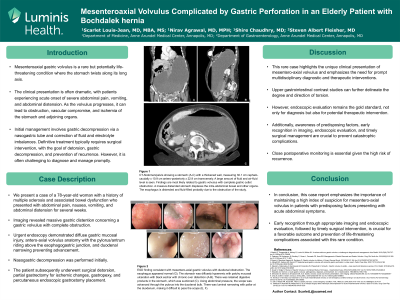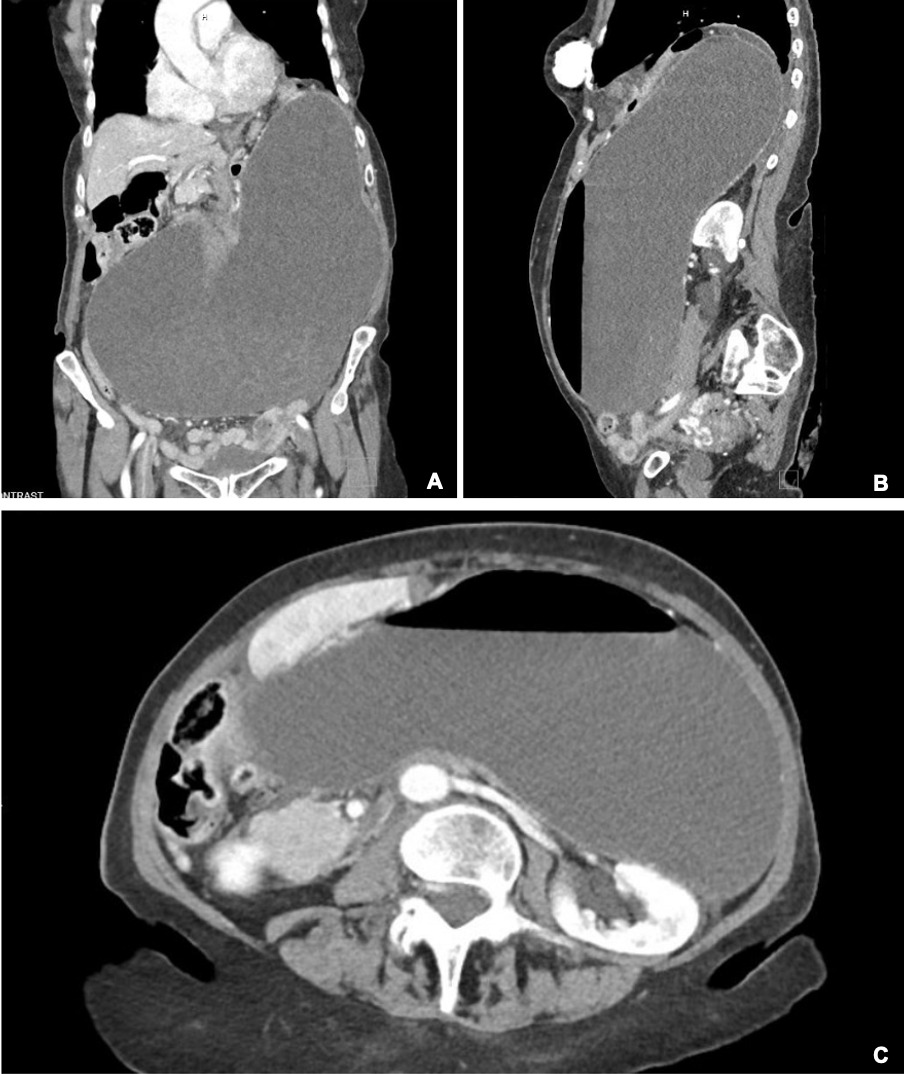Monday Poster Session
Category: Stomach
P3341 - Mesenteroaxial Volvulus Complicated by Gastric Perforation in an Elderly Patient With Bochdalek Hernia
Monday, October 28, 2024
10:30 AM - 4:00 PM ET
Location: Exhibit Hall E

Has Audio

Scarlet Louis-Jean, MD, MBA, MSAN
Luminis Health Anne Arundel Medical Center
Annapolis, MD
Presenting Author(s)
Award: Presidential Poster Award
Scarlet Louis-Jean, MD, MBA, MSAN, Nirav Agrawal, MBBS, MPH, Shire Chaudhry, MBBS, Steven Fleisher, MD
Luminis Health Anne Arundel Medical Center, Annapolis, MD
Introduction: Mesenteroaxial gastric volvulus is a rare but potentially life-threatening condition where the stomach twists along its long axis. The clinical presentation is often dramatic, with patients experiencing acute onset of severe abdominal pain, vomiting, and abdominal distension. As the volvulus progresses, it can lead to obstruction, vascular compromise, and ischemia of the stomach and adjoining organs. Initial management involves gastric decompression via a nasogastric tube and correction of fluid and electrolyte imbalances. Definitive treatment typically requires surgical intervention, with the goal of detorsion, gastric decompression, and prevention of recurrence. However, it is often challenging to diagnose and manage promptly.
Case Description/Methods: We present a case of a 78-year-old woman with a history of multiple sclerosis and associated bowel dysfunction who presented with abdominal pain, nausea, vomiting, and abdominal distension for several weeks. Imaging revealed massive gastric distention concerning for a gastric volvulus with complete obstruction. Urgent endoscopy demonstrated diffuse gastric mucosal injury, antero-axial volvulus anatomy with the pylorus/antrum riding above the esophagogastric junction, and duodenal narrowing preventing advancement. Nasogastric decompression was performed initially. The patient subsequently underwent surgical detorsion, partial gastrectomy for ischemic changes, gastropexy, and percutaneous endoscopic gastrostomy placement. Intraoperatively, a Bochdalek hernia defect was also identified as the precipitating factor. Postoperatively, the patient recovered well with bowel regimen and pain control and was discharged home.
Discussion: This rare case highlights the unique clinical presentation of mesenteroaxial volvulus and emphasizes the need for prompt multidisciplinary diagnostic and therapeutic interventions. Upper gastrointestinal contrast studies can further delineate the degree and direction of torsion. However, endoscopic evaluation remains the gold standard, not only for diagnosis but also for potential therapeutic intervention. Additionally, awareness of predisposing factors, early recognition in imaging, endoscopic evaluation, and timely surgical management are crucial to prevent catastrophic complications. Close postoperative monitoring is essential given the high risk of recurrence.

Disclosures:
Scarlet Louis-Jean, MD, MBA, MSAN, Nirav Agrawal, MBBS, MPH, Shire Chaudhry, MBBS, Steven Fleisher, MD. P3341 - Mesenteroaxial Volvulus Complicated by Gastric Perforation in an Elderly Patient With Bochdalek Hernia, ACG 2024 Annual Scientific Meeting Abstracts. Philadelphia, PA: American College of Gastroenterology.
Scarlet Louis-Jean, MD, MBA, MSAN, Nirav Agrawal, MBBS, MPH, Shire Chaudhry, MBBS, Steven Fleisher, MD
Luminis Health Anne Arundel Medical Center, Annapolis, MD
Introduction: Mesenteroaxial gastric volvulus is a rare but potentially life-threatening condition where the stomach twists along its long axis. The clinical presentation is often dramatic, with patients experiencing acute onset of severe abdominal pain, vomiting, and abdominal distension. As the volvulus progresses, it can lead to obstruction, vascular compromise, and ischemia of the stomach and adjoining organs. Initial management involves gastric decompression via a nasogastric tube and correction of fluid and electrolyte imbalances. Definitive treatment typically requires surgical intervention, with the goal of detorsion, gastric decompression, and prevention of recurrence. However, it is often challenging to diagnose and manage promptly.
Case Description/Methods: We present a case of a 78-year-old woman with a history of multiple sclerosis and associated bowel dysfunction who presented with abdominal pain, nausea, vomiting, and abdominal distension for several weeks. Imaging revealed massive gastric distention concerning for a gastric volvulus with complete obstruction. Urgent endoscopy demonstrated diffuse gastric mucosal injury, antero-axial volvulus anatomy with the pylorus/antrum riding above the esophagogastric junction, and duodenal narrowing preventing advancement. Nasogastric decompression was performed initially. The patient subsequently underwent surgical detorsion, partial gastrectomy for ischemic changes, gastropexy, and percutaneous endoscopic gastrostomy placement. Intraoperatively, a Bochdalek hernia defect was also identified as the precipitating factor. Postoperatively, the patient recovered well with bowel regimen and pain control and was discharged home.
Discussion: This rare case highlights the unique clinical presentation of mesenteroaxial volvulus and emphasizes the need for prompt multidisciplinary diagnostic and therapeutic interventions. Upper gastrointestinal contrast studies can further delineate the degree and direction of torsion. However, endoscopic evaluation remains the gold standard, not only for diagnosis but also for potential therapeutic intervention. Additionally, awareness of predisposing factors, early recognition in imaging, endoscopic evaluation, and timely surgical management are crucial to prevent catastrophic complications. Close postoperative monitoring is essential given the high risk of recurrence.

Figure: Figure 1. CT Abdomen/pelvis showing a stomach (A-C) with a thickened wall, measuring 30.1 cm cephalo caudally x 10.9 cm anteroposteriorly x 22.9 cm transversely. A large amount of fluid and air-fluid level is seen. Findings are most likely related to gastric volvulus with complete gastric callus obstruction. A massive distended stomach displaces the intra-abdominal bowel and other organs. The esophagus is distended and fluid-filled probably due to the obstruction of the study.
Disclosures:
Scarlet Louis-Jean indicated no relevant financial relationships.
Nirav Agrawal indicated no relevant financial relationships.
Shire Chaudhry indicated no relevant financial relationships.
Steven Fleisher indicated no relevant financial relationships.
Scarlet Louis-Jean, MD, MBA, MSAN, Nirav Agrawal, MBBS, MPH, Shire Chaudhry, MBBS, Steven Fleisher, MD. P3341 - Mesenteroaxial Volvulus Complicated by Gastric Perforation in an Elderly Patient With Bochdalek Hernia, ACG 2024 Annual Scientific Meeting Abstracts. Philadelphia, PA: American College of Gastroenterology.


